Concept and Realisation of ISFET-Based Measurement Modules for Infield Soil Nutrient Analysis and Hydroponic Systems
Abstract
1. Introduction
2. Materials and Methods
2.1. Functional Principle of the ISFET Sensor
- Temperature: Changes in the ambient temperature or the temperature of the measurement solution can influence the accuracy and stability of the ISFET sensor measurement because they can affect the properties of the semiconductor materials and the reaction rates in the solution. In extreme cases, excessive temperatures can destroy the sensor.
- Moisture: Moisture can affect the performance of the sensor, especially if the moisture enters the electronics of the sensor, causing corrosion of the contacts or internal shorting.
- Light Sensitivity: Changes in ambient light conditions can affect the stability and accuracy of the ISFET output signal. This is due to the fact that light can affect the electrical properties of the semiconductor material that is used to detect the ions [34].
- Electrical interference: Other ions or chemical compounds in the sample solution can interfere with the ISFET sensor’s output signal, especially if they have similar charges or interactions with the sensor’s gate surface. The ISFET sensor output signal can be distorted by electrical or electromagnetic interference from other sources [35].
- Mechanical stress: Mechanical stress, such as severe vibration or increased pressure, can affect the sensitivity of the sensor and the stability of the output signal, or lead to malfunction or total failure of the electronic circuitry [36].
2.2. Structure of the ISFET Measurement Modules
2.2.1. Soil Application
2.2.2. Hydroponic Application
2.3. Control and Readout Electronic
3. System Integration
3.1. Concept
3.1.1. Soil Application
3.1.2. Hydroponic Application
3.2. Realisation
3.2.1. Soil Application
3.2.2. Hydroponic Application
3.3. First Experiments and Results
- Validation of the developed control and readout electronics.
- Validation of the ISFET sensor modules in combination with the control and readout electronics.
- Validation of the implemented preventive measures against known interfering factors.
- Validation of the overall ISFET-based measurement system under real measurement conditions.
- Stability: Stability was described by the sensitivity of the ISFET chip and the drift during the measurement. Stability was defined as a horizontal measurement curve with an acceptable level of noise in the measured value.
- Reproducibility: Reproducibility meant that a sensor gave the same measurement result after repeated measurements with the same measurement solution concentration.
- Response behaviour: The response behaviour described the course of the measurement curve when the measurement solution concentration changed.
- Selectivity: In this context, selectivity described the ion selectivity or ion sensitivity of the ISFEF sensor to the defined ion.
- All inactive ISFET sensors were grounded.
- A time delay of 180 ms was implemented in the software for the sampling of the output signal of the active ISFET sensor to allow the residual capacitance of the previous ISFET sensor to dissipate (so-called time delay).
4. Discussion
5. Conclusions
Author Contributions
Funding
Data Availability Statement
Conflicts of Interest
References
- Bergveld, P. Short Communications: Development of an Ion-Sensitive Solid-State Device for Neurophysiological Measurements. IEEE Trans. Biomed. Eng. 1970, 70–71. [Google Scholar] [CrossRef] [PubMed]
- Matsuo, T.; Wise, K.D. An integrated field effect electrode for biopotential recording. IEEE Trans. Biomed. Eng. 1974, 485–487. [Google Scholar] [CrossRef]
- Caras, S.; Jiri, J. Field effect transistor sensitive to penicillin. Anal. Chem. 1980, 52, 1935–1937. [Google Scholar] [CrossRef]
- Bergveld, P. Thirty years of ISFETOLOGY. What happened in the past 30 years and what may happen in the next 30 years. Sens. Actuators B Chem. 2003, 88, 1–20. [Google Scholar] [CrossRef]
- Middelhoek, S. Celebration of the tenth transducers conference: The past, present and future of transducer research and development. Sens. Actuators A Phys. 2000, 82, 2–23. [Google Scholar] [CrossRef]
- Petersen, K.E. Silicon as a mechanical material. Proc. IEEE 1982, 70, 420–457. [Google Scholar] [CrossRef]
- Kim, H.J.; Hummel, J.W.; Sudduth, K.A.; Motavalli, P.P. Simultaneous analysis of soil macronutrients using ion-selective electrodes. Soil Sci. Soc. Am. J. 2007, 71, 1867–1877. [Google Scholar] [CrossRef]
- Sibley, K.J.; Brewster, G.R.; Adsett, J.F.; Struik, P.C.; Astatkie, T. In-Field Measurement of Soil Nitrate Using an Ion-Selective Electrode; INTECH Open Access Publisher. 2010. Available online: https://www.intechopen.com/chapters/9958 (accessed on 15 May 2024). [CrossRef]
- Viscarra Rossel, R.A.; Thylén, L.; McBratney, A.B.; Gilbertsson, M. Development of an on-the-go soil sensing system for determinations of soil pH and lime requirement. In Proceedings of the 7th International Conference on Precision Agriculture and Other Precision Resources Management, Minneapolis, MN, USA, 25 July 2004. [Google Scholar]
- Sethuramasamyraja, B.; Adamchuk, V.I.; Dobermann, A.; Marx, D.B.; Jones, D.D.; Meyer, G.E. Agitated soilmeasurement method for integrated on-the-go mapping of soil pH, potassium and nitrate contents. Comput. Electron. Agric. 2008, 60, 212–225. [Google Scholar] [CrossRef]
- Piepel, M.F.; Dittert, K.; Olfs, H.W. Ion-selective electrodes for quick on-farm determination of ammonium and potassium concentrations in pig slurry. J. Plant Nutr. Soil Sci. 2023, 186, 266–275. [Google Scholar] [CrossRef]
- Piepel, M.F.; Olfs, H.W. Development of a Physicochemical Test Kit for On-Farm Measurement of Nutrients in Liquid Organic Manures. Agriculture 2023, 13, 477. [Google Scholar] [CrossRef]
- Son, J.E.; Kim, H.J.; Ahn, T.I. Hydroponic systems. In Plant Factory, 2nd ed.; Kozai, T., Niu, G., Takagaki, M., Eds.; Academic Press, 2020; pp. 273–283. [CrossRef]
- De Marco, R.; Clarke, G.; Pejcic, B. Ion-selective electrode potentiometry in environmental analysis. Electroanal. Int. J. Devoted Fundam. Pract. Asp. Electroanal. 2007, 19, 1987–2001. [Google Scholar] [CrossRef]
- Benslimane, O.; Rabie, R.; El Hajjaji, S. The Use of ISFET for the Measurement of Phosphorus in Moroccan Soils. In International Conference on Advanced Intelligent Systems for Sustainable Development, 1st ed.; Kacprzyk, J., Ezziyyani, M., Balas, V.E., Eds.; Springer Nature: Cham, Switzerland, 2023; pp. 462–468. [Google Scholar] [CrossRef]
- Benslimane, O.; Rabie, R.; Saidi, O.; Itqiq, S.E.; Bouzida, I.; Lakssir, B.; Hajjaji, S.E. Nitrate measurement of Moroccan soil through Ion Sensitive Field Effect Transistor (ISFET). Meas. Sens. 2023, 29, 100879. [Google Scholar] [CrossRef]
- Chen, X.; Zhou, G.; Mao, S.; Chen, J. Rapid detection of nutrients with electronic sensors: A review. Environ. Sci. Nano 2018, 5, 837–862. [Google Scholar] [CrossRef]
- Gieling, T.H.; Van Straten, G.; Janssen, H.J.J.; Wouters, H. ISE and Chemfet sensors in greenhouse cultivation. Sens. Actuators B Chem. 2005, 105, 74–80. [Google Scholar] [CrossRef]
- Bamsey, M.; Graham, T.; Thompson, C.; Berinstain, A.; Scott, A.; Dixon, M. Ion-specific nutrient management in closed systems: The necessity for ion-selective sensors in terrestrial and space-based agriculture and water management systems. Sensors 2012, 12, 13349–13392. [Google Scholar] [CrossRef] [PubMed]
- Pullano, S.A.; Critello, C.D.; Mahbub, I.; Tasneem, N.T.; Shamsir, S.; Islam, S.K.; Greco, M.; Fiorillo, A.S. EGFET-based sensors for bioanalytical applications: A review. Sensors 2018, 18, 40–42. [Google Scholar] [CrossRef] [PubMed]
- Taylor Archbold, G.; Parra, C.; Carrillo, H.; Mouazen, A. A decision framework reference for ISFET sensor-based electronic systems design for agriculture industry applications. In Proceedings of the 2020 IEEE 17th India Council International Conference (INDICON), New Delhi, India, 10 December 2020. [Google Scholar] [CrossRef]
- Poghossian, A.; Berndsen, L.; Lueth, H.J.; Schoening, M.J. Novel concept for flow-rate and flow-direction determination by means of pH-sensitive ISFETs. Microfluid. BioMEMS 2001. [Google Scholar] [CrossRef]
- Matsuo, T.; Esashi, M. Methods of ISFET fabrication. Sens. Actuators 1981, 1, 77–96. [Google Scholar] [CrossRef]
- Gasparyan, L.; Mazo, I.; Simonyan, V.; Gasparyan, F. ISFET Based DNA Sensor: Current-Voltage Characteristic and Sensitivity to DNA Molecules. Open J. Biophys. 2019, 9, 239–253. [Google Scholar] [CrossRef][Green Version]
- Archbold, G.; Parra, C.; Carrillo, H.; Mouazen, A.M. Towards the implementation of ISFET sensors for in-situ and real-time chemical analyses in soils: A practical review. Comput. Electron. Agric. 2023, 209, 107828. [Google Scholar] [CrossRef]
- Galup-Montoro, C.; Schneider, M.C. MOSFET Modeling for Circuit Analysis and Design; World Scientific: Singapore, 2007. [Google Scholar] [CrossRef][Green Version]
- Malik, N.R. Electronic Circuits: Analysis, Simulation, and Design; Prentice Hall: Englewood Cliffs, NJ, USA, 1995. [Google Scholar]
- Estrela, P.; Pachauri, V.; Ingebrandt, S. Biologically sensitive field-effect transistors: From ISFETs to NanoFETs. Essays Biochem. 2016, 60, 81–90. [Google Scholar] [CrossRef] [PubMed]
- Shoorideh, K.; Chui, C.O. Optimization of the Sensitivity of FET-Based Biosensors via Biasing and Surface Charge Engineering. IEEE Trans. Electron Devices 2012, 59, 3104–3110. [Google Scholar] [CrossRef]
- Alkhasov, S.S.; Mileshko, L.P.; Khlebinskaya, A.S. Principle of operation and main using spheres of ion-selective field-effect transistors. Sci. Online Mag. Technosphere Secur. Technol. 2014, 1–6. Available online: https://agps-2006.narod.ru/ttb/2014-5/29-05-14.ttb.pdf (accessed on 31 May 2024).
- Janata, J. Potentiometric microsensors. Chem. Rev. 1990, 90, 691–703. [Google Scholar] [CrossRef]
- Schasfoort, B.M.; Bergveld, P.; Kooyman, R.P.H.; Greve, J. Possibilities and limitations of direct detection of protein charges by means of an immunological field-effect transistor. Anal. Chim. Acta 1990, 238, 323–329. [Google Scholar] [CrossRef]
- Van Hal, R.E.G.; Eijkel, J.C.T.; Bergveld, P. A novel description of ISFET sensitivity with the buffer capacity and double-layer capacitance as key parameters. Sens. Actuators B Chem. 1995, 24, 201–205. [Google Scholar] [CrossRef]
- Ito, Y. Stability of ISFET and its new measurement protocol. Sens. Actuators B Chem. 2000, 66, 53–55. [Google Scholar] [CrossRef]
- Baldi, A.; Bratov, A.; Mas, R.; Domınguez, C. Electrostatic discharge sensitivity tests for ISFET sensors. Sens. Actuators B Chem. 2001, 80, 255–260. [Google Scholar] [CrossRef]
- Bernstein, H. Grundlagen für die Entwicklung elektronischer Systeme. In Elektronik und Mechanik, 5th ed.; Springer: Wiesbaden, Germany, 2023. [Google Scholar] [CrossRef]
- Lehmann, U.; Grisel, A. Miniature multisensor probe for soil nutrient monitoring. Procedia Eng. 2014, 87, 1429–1432. [Google Scholar] [CrossRef]
- Tsukor (Riedel), V.; Hinck, S.; Nietfeld, W.; Mosler, T.; Tesch, H.; Lorenz, F.; Najdenko, E.; Möller, A.; Mentrup, D.; Ruckelshausen, A. Automated mobile field laboratory for on-the-go soil-nutrient analysis with the ISFET multi-sensor module. In Proceedings of the 77th International Conference on Agricultural Engineering (AgEng 2019), Hannover, Germany, 8 November 2019; Available online: https://elibrary.vdi-verlag.de/10.51202/9783181023617-377/automated-mobile-field-laboratory-for-on-the-go-soilnutrient-analysis-with-the-isfet-multi-sensor-module?page=1 (accessed on 31 May 2024).
- Hefele, M.; Müllner, E.; Brederlow, R.; Lösel, A.; Meier, S.; Pfeffer, C.; Kreupl, F.; Wolf, B. Integrated multipurpose analog front-end for electrochemical ISFET sensors. In Proceedings of the 17th IEEE International New Circuits and Systems Conference (NEWCAS), Munich, Germany, 23 June 2019. [Google Scholar] [CrossRef]
- Das, M.P.; Bhuyan, M.; Talukdar, C. Readout Circuits for Noise Compensation in ISFET Sensory System. Sens. Imaging 2015, 16. [Google Scholar] [CrossRef]
- Riedel, V. ISFET Sensors Measurement Data For Soil Nutrient Analysis. 2024. Available online: https://data.goettingen-research-online.de/dataset.xhtml?persistentId=doi:10.25625/UTIMMI (accessed on 31 May 2024). [CrossRef]
- Hinck, S.; Möller, A.; Terhaag, M.; Meyer, T.; Mentrup, D.; Kerssen, H.; Najdenko, E.; Lorenz, F.; Mosler, T.; Tesch, H.; et al. Analyse-to-go on the field: prototypes4soil2data. In Proceedings of the 22nd World Congress of Soil Science, Glasgow, Scotland, 31 July 2022. [Google Scholar] [CrossRef]
- Hinck, S.; Möller, A.; Mentrup, D.; Najdenko, E.; Lorenz, F.; Mosler, T.; Tesch, H.; Nietfeld, W.; Scholz, C.; Tsukor, V.; et al. soil2data: Concept for a mobile field laboratory for nutrient analysis. In Proceedings of the 14th International Conference on Precision Agriculture (unpaginated, online), Montreal, QC, Canada, 2 June 2018; Available online: https://www.ispag.org/proceedings/?action=download&item=5317 (accessed on 31 May 2024).
- Najdenko, E.; Lorenz, F.; Olfs, H.-W.; Dittert, K. Development of an express method for measuring soil nitrate, phosphate, potassium, and pH for future in-field application. J. Plant Nutr. Soil Sci. 2023, 186, 623–632. [Google Scholar] [CrossRef]
- VDLUFA. Handbuch der Landwirtschaftlichen Versuchs- und Untersuchungsmethodik (VDLUFA-Methodenbuch). Vol. I, Die Untersuchung von Böden. (Handbook of Agricultural Research- and Testing Methods, Vol. I, The Testing of Soils); VDLUFA, Verband Deutscher Landwirtschaftlicher Untersuchungs- und Forschungsanstalten (German Association of Agricultural Analysis and Research Institutes): Darmstadt, Germany, 2016. [Google Scholar]
- Sardare, M.D.; Admane, S.V. A review on plant without soil-hydroponics. Int. J. Res. Eng. Technol. 2013, 2, 299–304. [Google Scholar]
- Benton Jones, J. Complete Guide for Growing Plants Hydroponically; CRC Press: Boca Raton, FL, USA, 2014. [Google Scholar]
- Jensen, M.H.; Collins, W.L. Hydroponic Vegetable Production. Hortic. Rev. 1985, 7, 483–559. [Google Scholar]
- Jakobsen, Ø.M.; Schiefloe, M.; Mikkelsen, Ø.; Paille, C.; Jost, A.I.K. Real-time monitoring of chemical water quality in closed-loop hydroponics. In Proceedings of the International Symposium on Advanced Technologies and Management for Innovative Greenhouses: GreenSys2019, Anger, France, 16 June 2020. [Google Scholar] [CrossRef]
- Riedel, V.; Möller, A.; Teerhag, M.; Meyer, T.; Mentrup, D.; Kerssen, H.; Najdenko, E.; Lorenz, F.; Mosler, T.; Tesch, H.; et al. Datenfluss bei der Applikation der Bodenbeprobung mit dem mobilen Feldlabor “soil2data”. In Proceedings of the 43rd GIL Annual Conference, Osnabrueck, Germany, 13 February 2023; Available online: https://dl.gi.de/server/api/core/bitstreams/b6a04a30-76e4-40fd-9179-7391a940c5d5/content (accessed on 31 May 2024).
- Schöning, M.J. Feldeffektstrukturen mit AgI-Aufdampfschichten als Chemische Sensoren (Field-Effect Structures with AgI Vapour Deposition Layers as Chemical Sensors). Ph.D. Thesis, University of Karlsruhe, Karlsruhe, Germany, 1993. [Google Scholar]
- Umezawa, Y.; Umezawa, K.; Bühlmann, P.; Hamada, N.; Aoki, H.; Nakanishi, J.; Sato, M.; Xiao, K.P.; Nishimura, Y. Potentiometric selectivity coefficients of ion-selective electrodes. Part II. Inorganic anions (IUPAC Technical Report). Pure Appl. Chem. 2002, 74, 923–994. [Google Scholar] [CrossRef]
- Chen, X.; Hu, Q.; Chen, S.; Netzer, N.L.; Wang, Z.; Zhang, S.; Zhang, Z. Multiplexed analysis of molecular and elemental ions using nanowire transistor sensors. Sens. Actuators B Chem. 2018, 270, 89–96. [Google Scholar] [CrossRef]
- Tarantov, Y.A.; Kartashev, A.S.; Kruchinin, A.A.; Bobrov, P.V.; Vlasov, Y.G.; Afanas’ev, V.V. Optical and thermal sensitivity of pH-ISFET with Ta2O5 membrane. Sens. Actuators A Phys. 1991, 28, 197–202. [Google Scholar] [CrossRef]
- Voorthuyzen, J.A.; Bergveld, P. Photoelectric effects in Ta2O5-SiO2-Si structures. Sens. Actuators B Chem. 1990, 1, 350–353. [Google Scholar] [CrossRef]
- Chin, Y.L.; Chou, J.C.; Sun, T.P.; Chung, W.Y.; Hsiung, S.K. A Novel pH Sensitive ISFET with on Chip Temperature Sensing Using CMOS Standard Process. Sens. Actuators B 2001, 76, 582–593. [Google Scholar] [CrossRef]
- Chou, J.C.; Wang, Y.F.; Lin, J.S. Temperature Effect of A-Si: H pH-ISFET. Sens. Actuators B 2000, 62, 92–96. [Google Scholar] [CrossRef]
- Elli, G.; Hamed, S.; Petrelli, M.; Ibba, P.; Ciocca, M.; Lugli, P.; Petti, L. Field-Effect Transistor-Based Biosensors for Environmental and Agricultural Monitoring. Sensors 2022, 22, 4178. [Google Scholar] [CrossRef]
- Hassan, E.A.; Abdolkader, T.M. A review of ion-sensitive field effect transistor (ISFET) based biosensors. Int. J. Mater. Technol. Innov. 2023, 3, 69–84. [Google Scholar] [CrossRef]
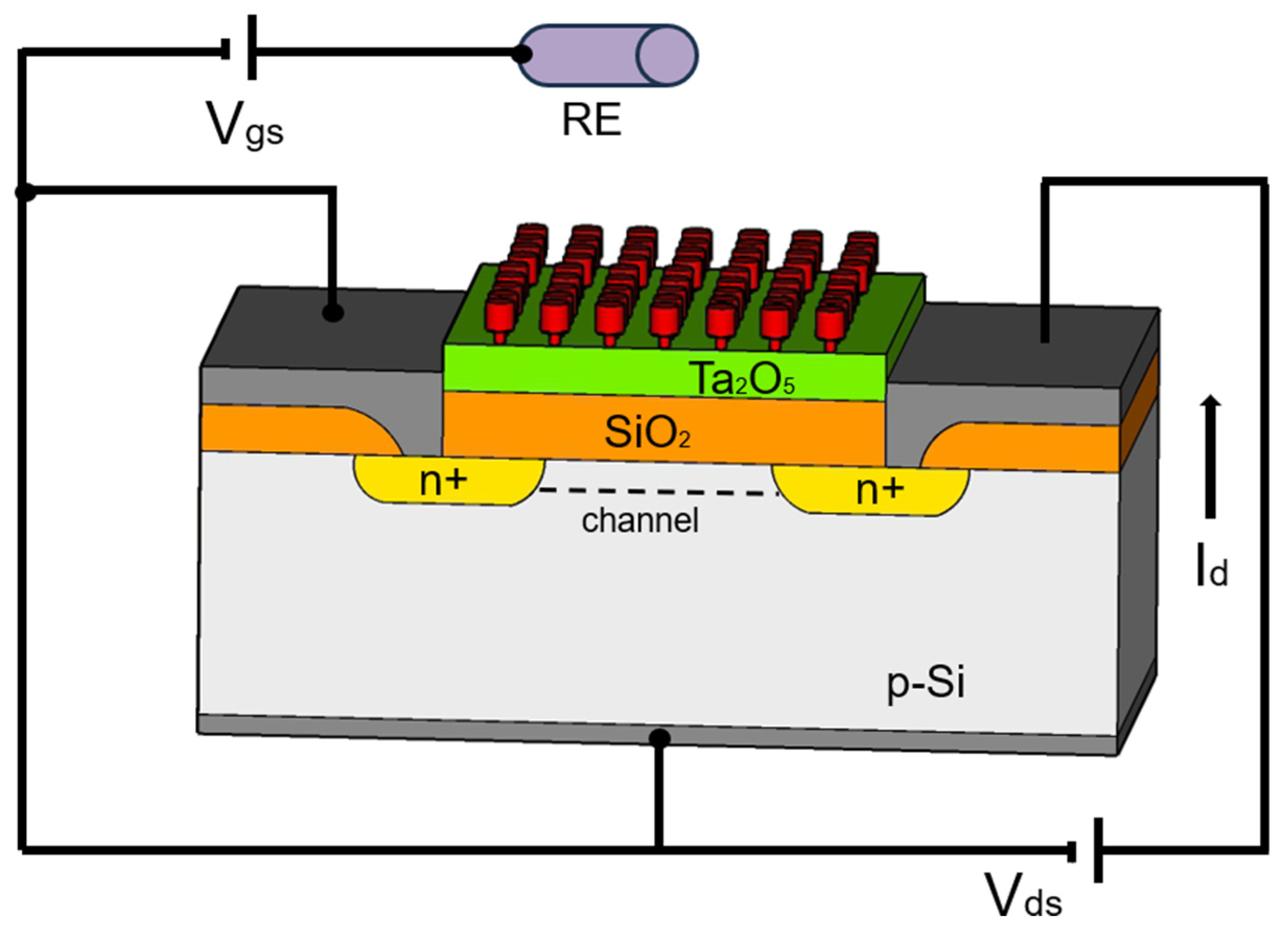






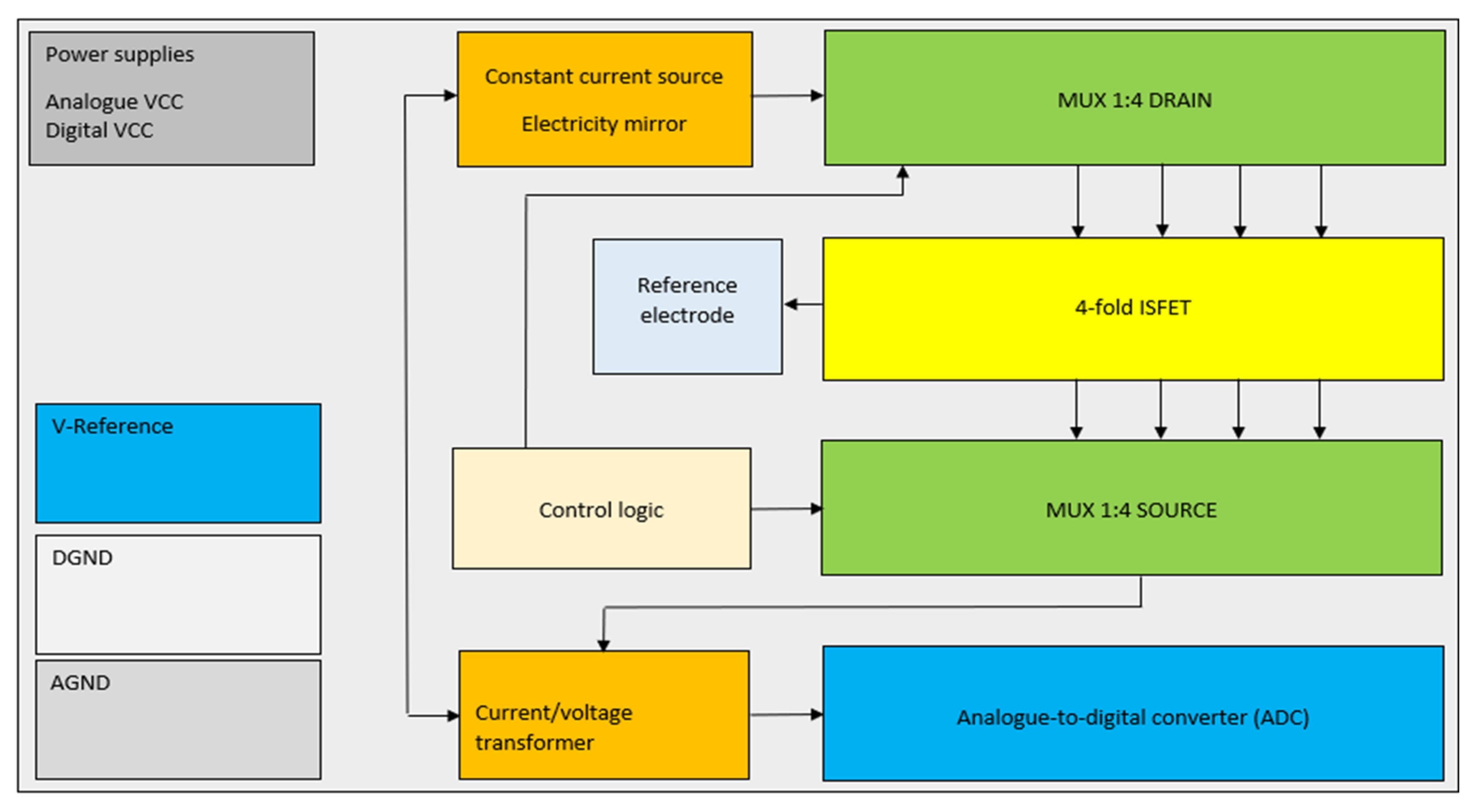

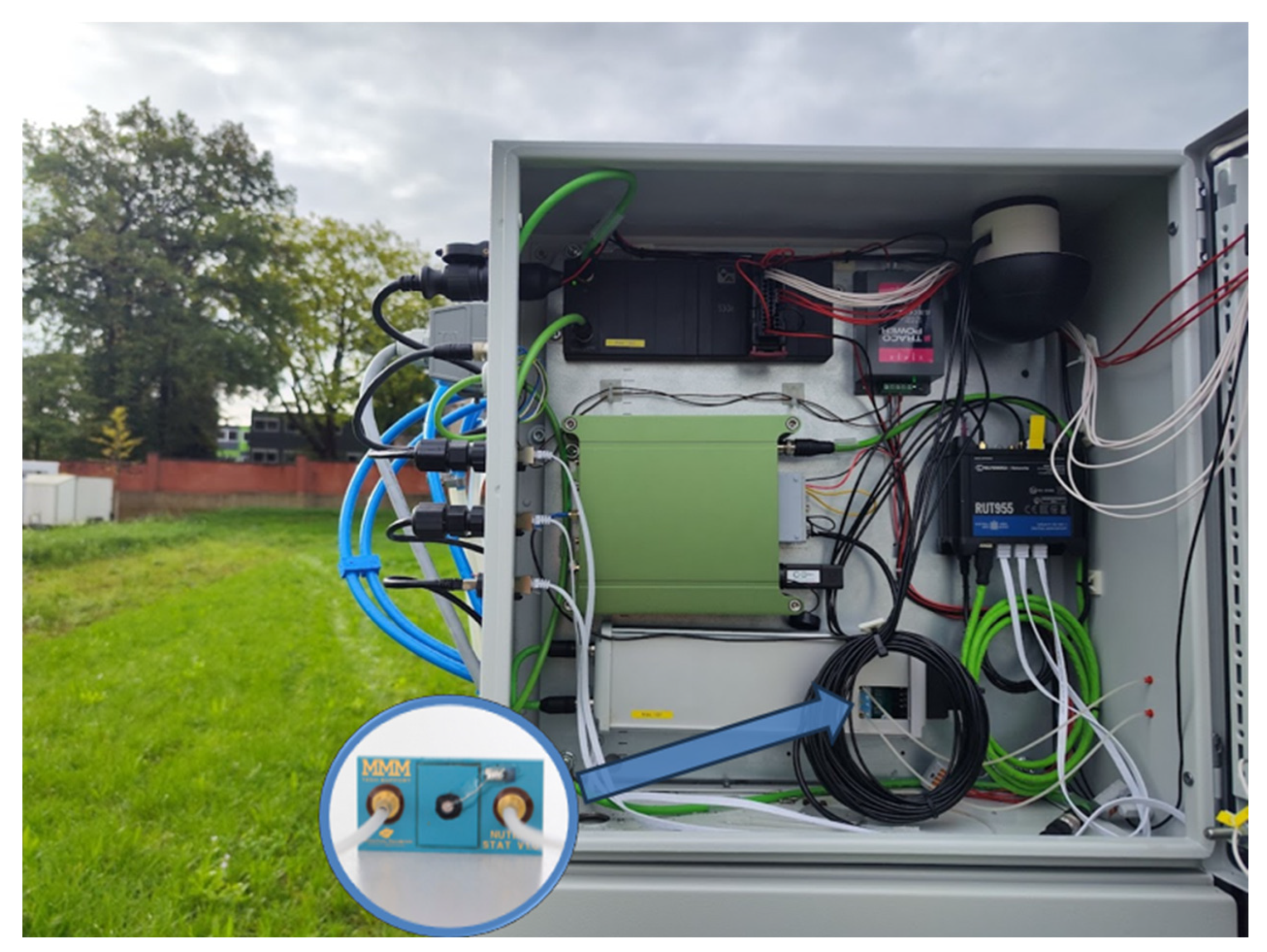
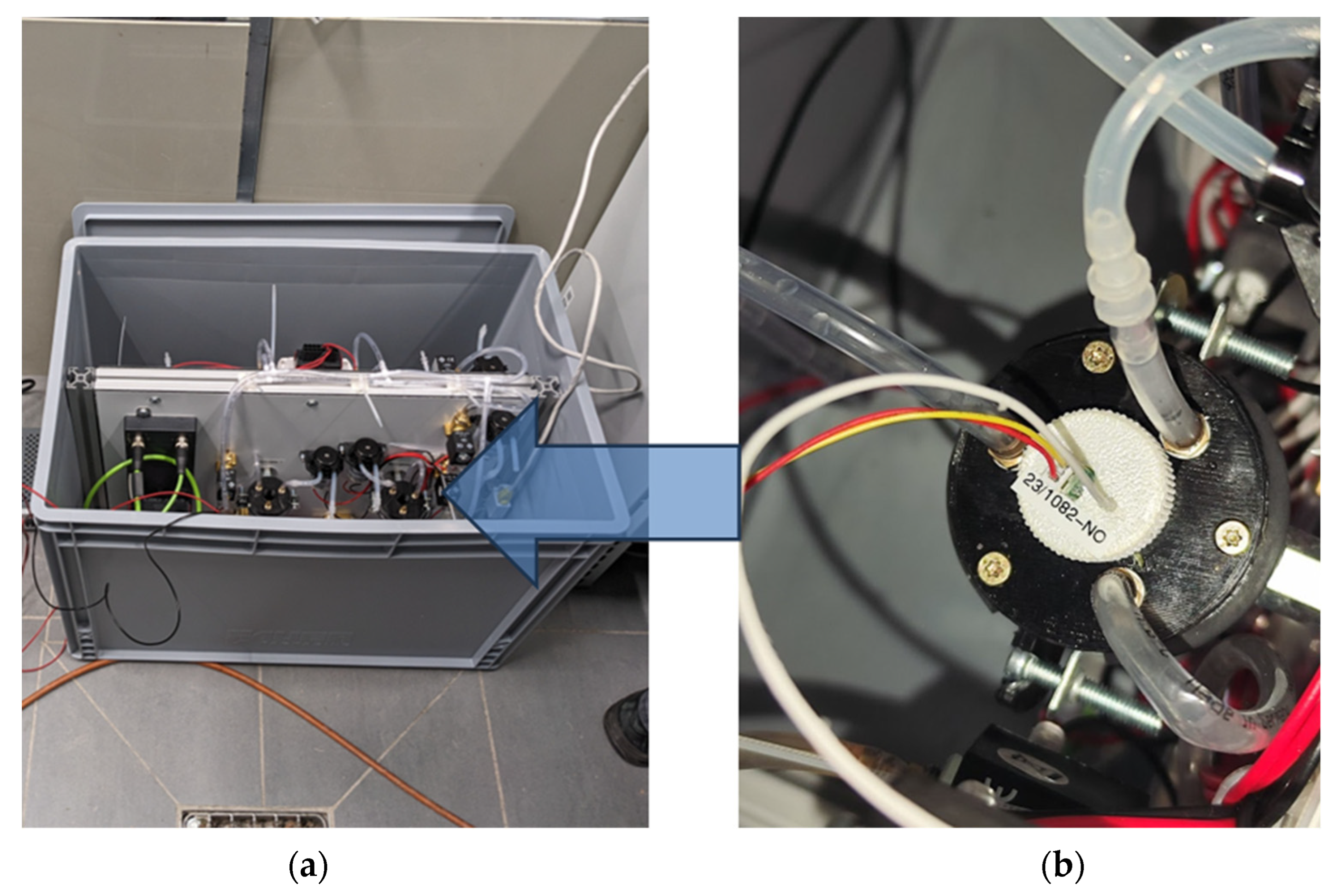
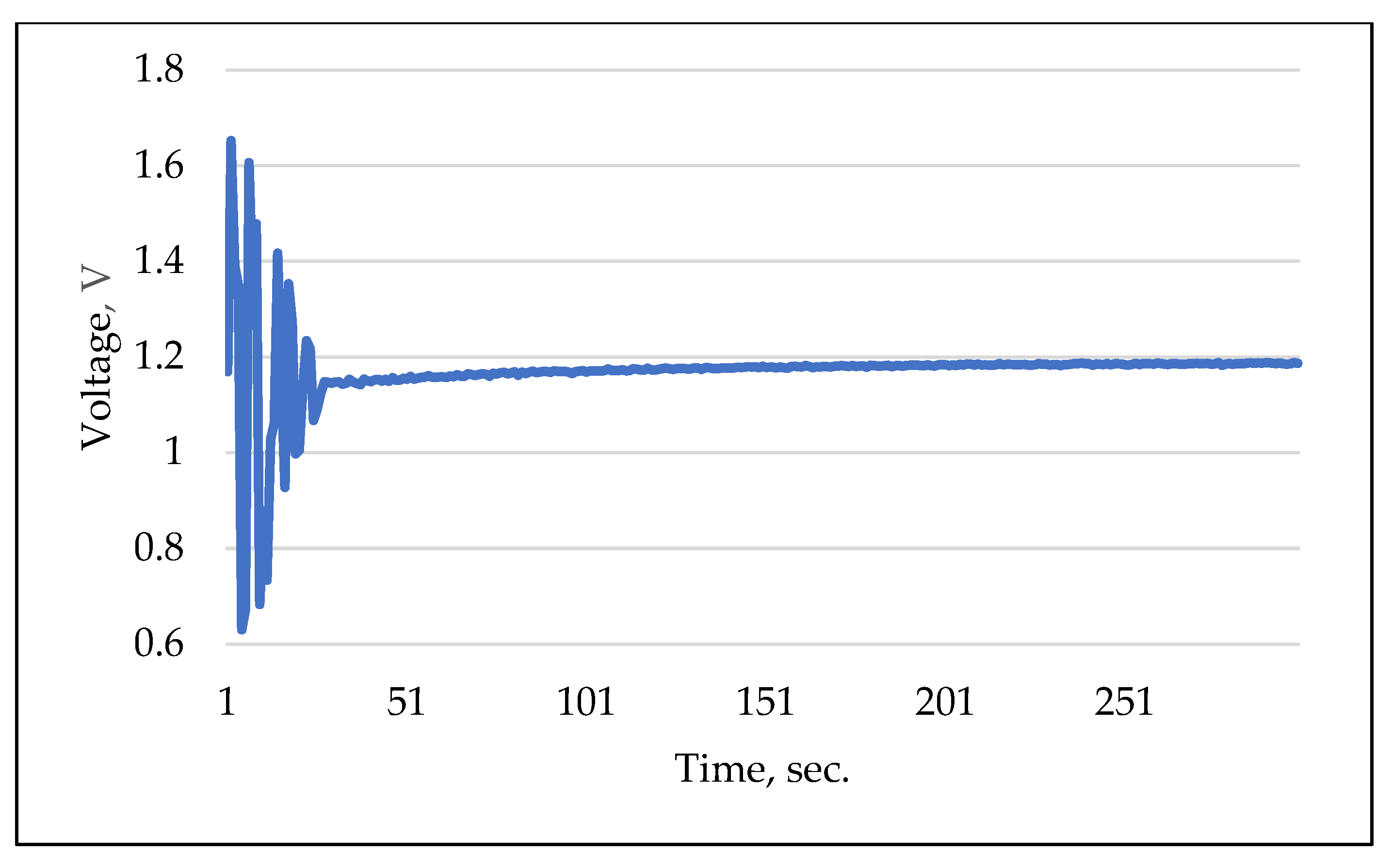
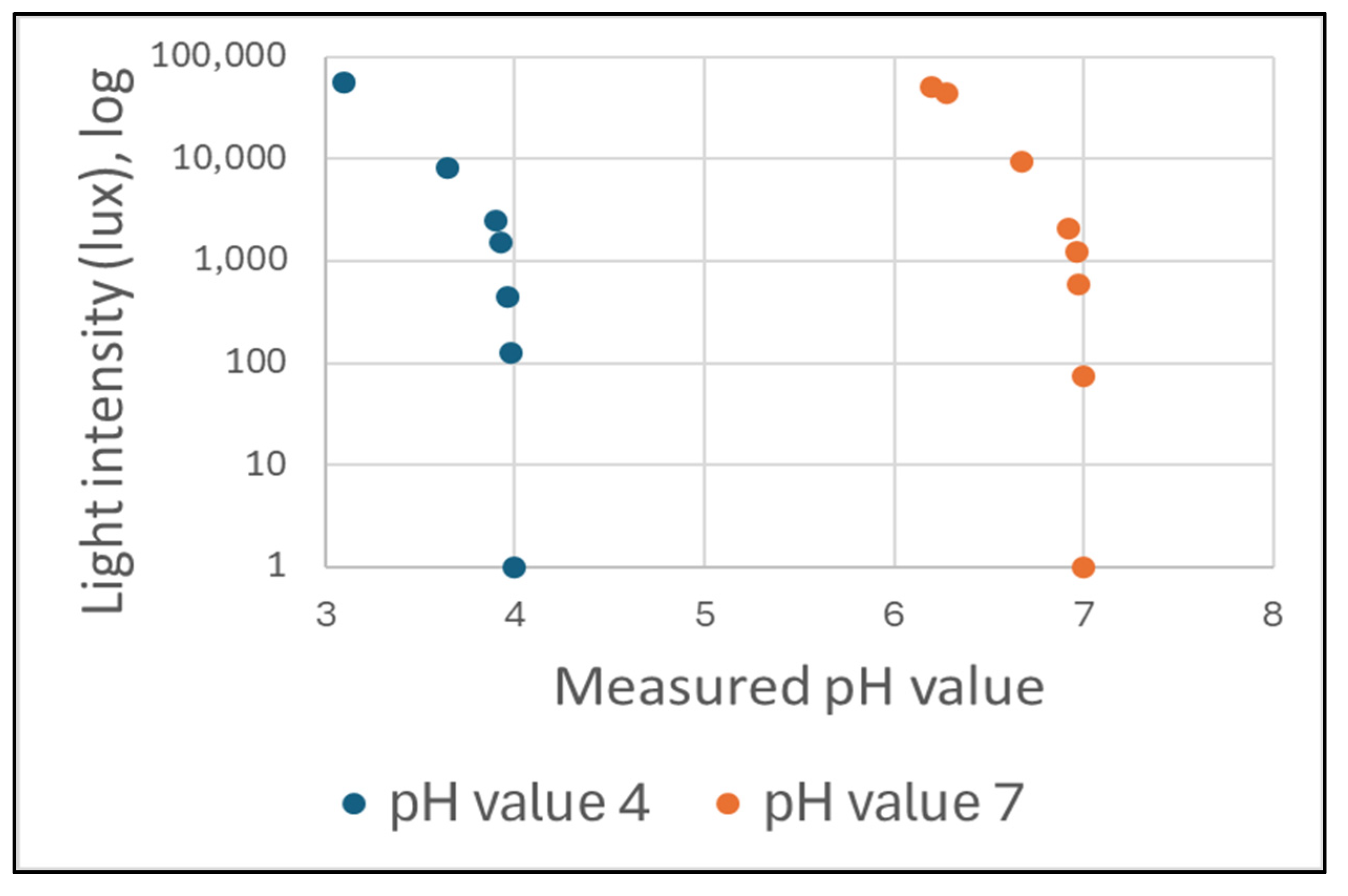


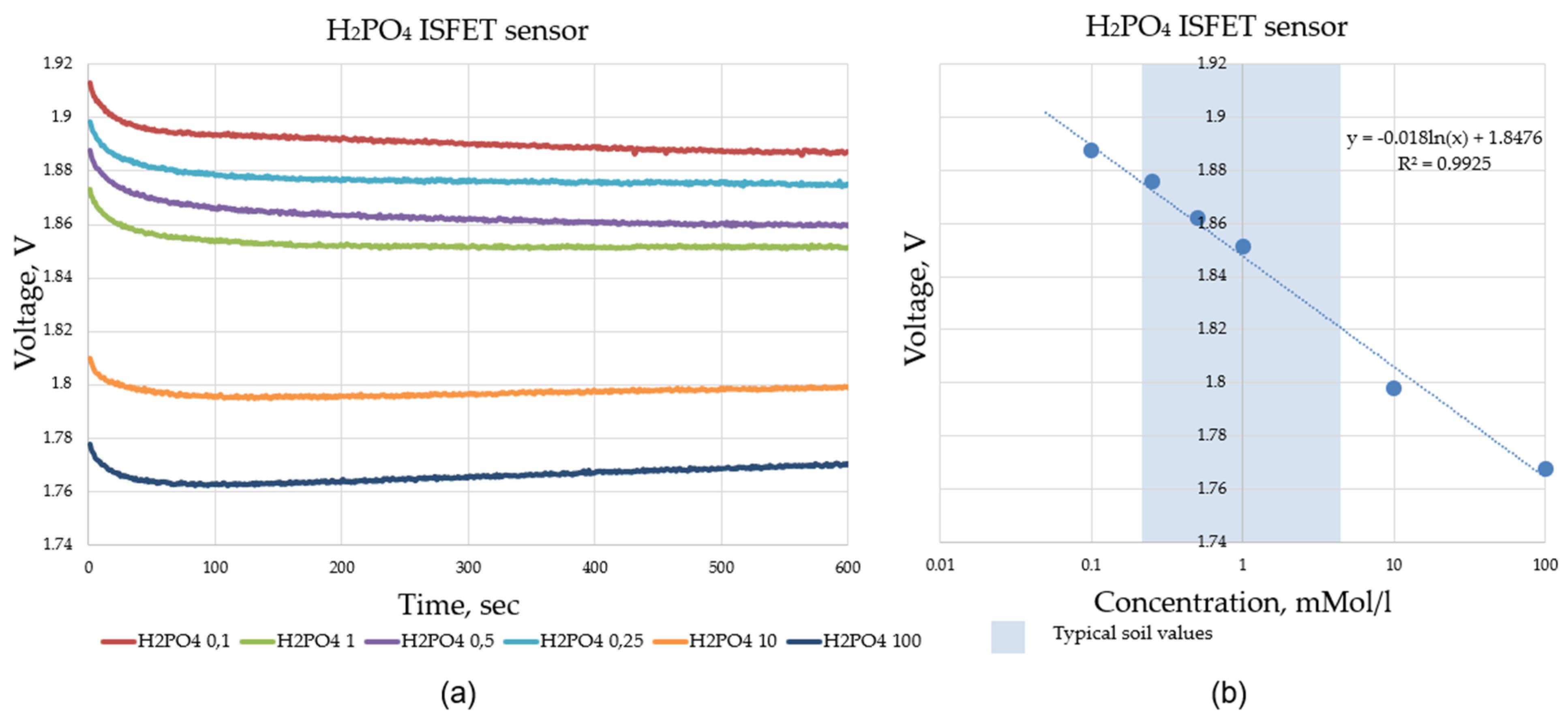
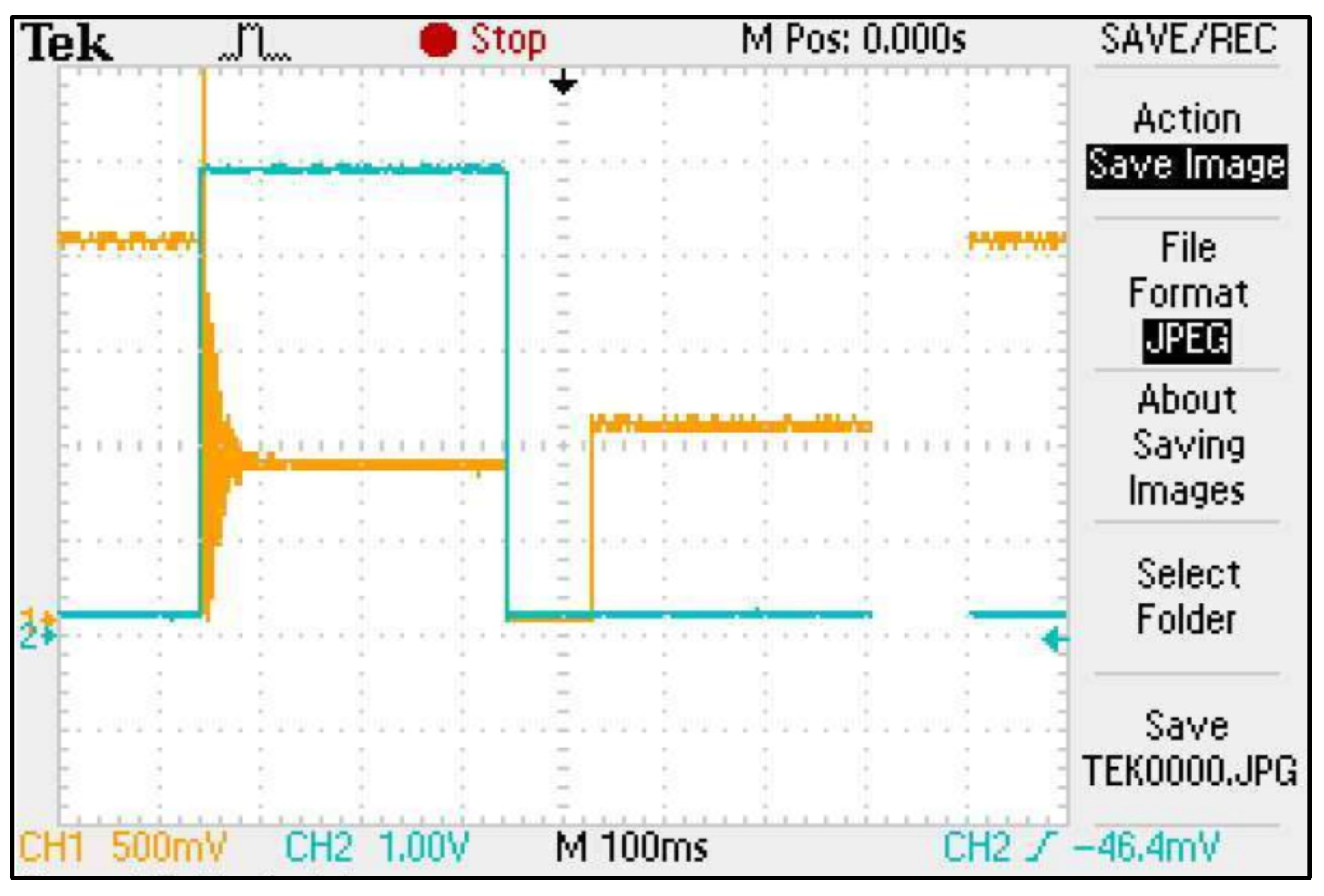
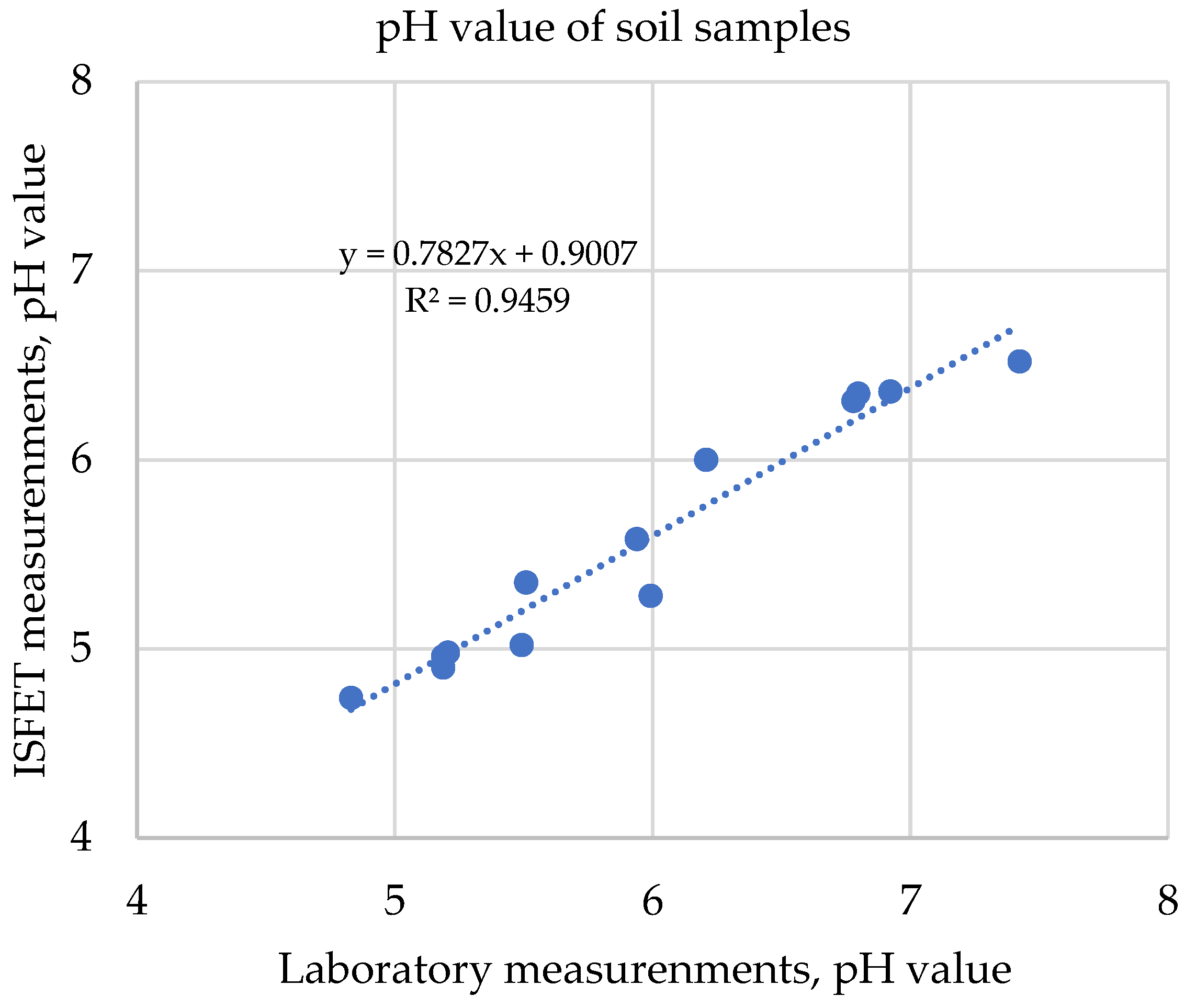
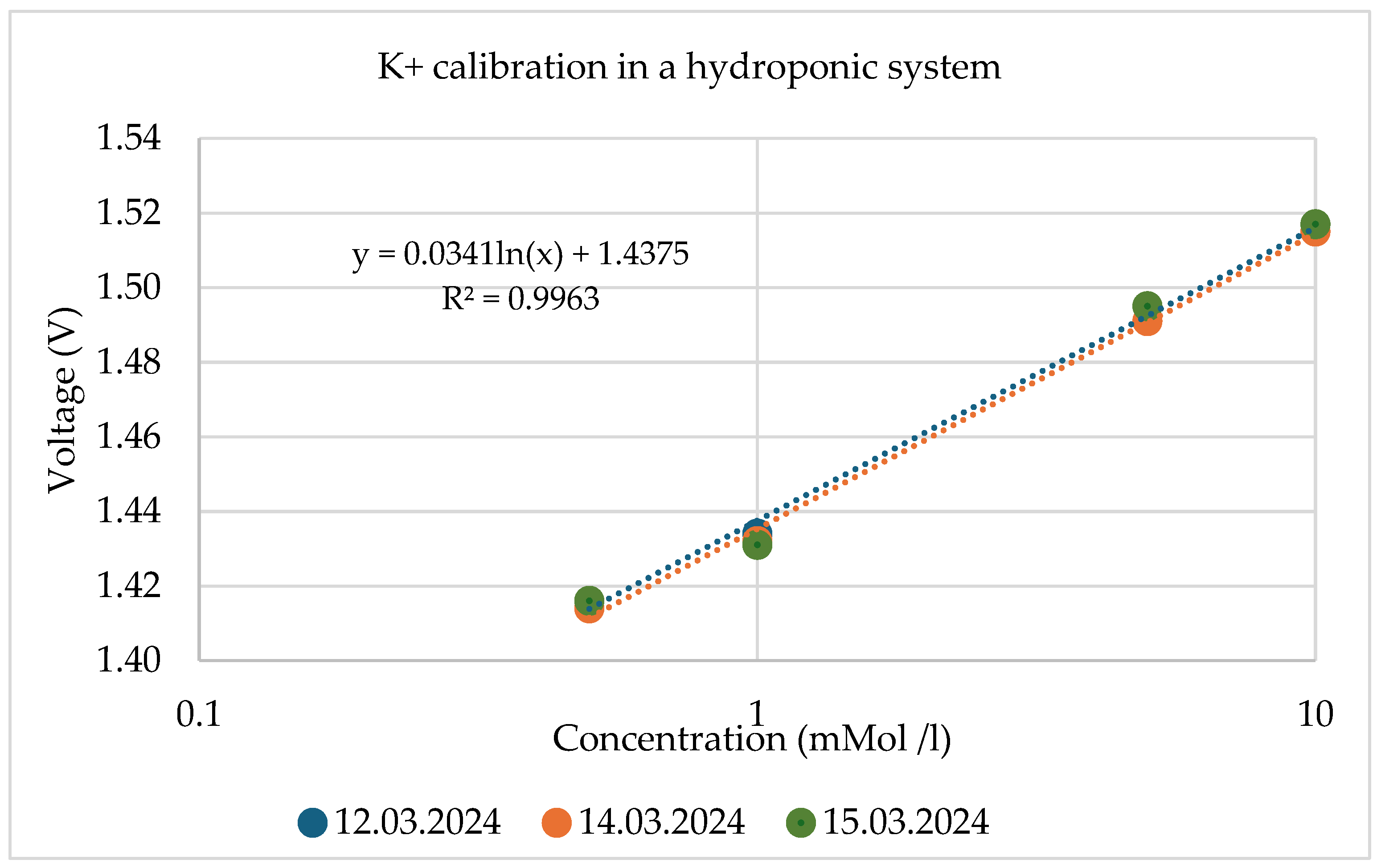
| Nutrient | Analysis Method | Extraction Agent | Ratio Soil/Extraction Agent | Processing Time |
|---|---|---|---|---|
| Nitrate nitrogen | VDLUFA/A 6.1.1 | CaCl2, c = 0.125 mol/L | 1:10 | 60 min |
| Phosphorus (plant-available) | VDLUFA/A 6.2.1.1 | Calcium acetate lactate (CAL) | 1:20 | 90 min |
| Potassium (plant-available) | VDLUFA/A 6.2.1.1 | Calcium acetate lactate (CAL) | 1:20 | 90 min |
| pH value | VDLUFA/A 5.1.1 | CaCl2, c = 0.01 mol/L | 1:2.5 | 60 min |
| Type of Construction | pH | ||||
|---|---|---|---|---|---|
| ISFET multi-sensor | 4 | nn | |||
| ISFET single | 4 |
| Concentration, mMol/L | 12 March 2024 Voltage, V | 14 March 2024 Voltage, V | 15 March 2024 Voltage, V | Mean Value Voltage, V | Mean Deviation, Voltage, V |
|---|---|---|---|---|---|
| 0.5 | 1.416 | 1.416 | 1.414 | 1.415 | 0.0012 |
| 1 | 1.431 | 1.434 | 1.432 | 1.432 | 0.0015 |
| 5 | 1.495 | 1.495 | 1.491 | 1.494 | 0.0023 |
| 10 | 1.517 | 1.515 | 1.515 | 1.516 | 0.0012 |
Disclaimer/Publisher’s Note: The statements, opinions and data contained in all publications are solely those of the individual author(s) and contributor(s) and not of MDPI and/or the editor(s). MDPI and/or the editor(s) disclaim responsibility for any injury to people or property resulting from any ideas, methods, instructions or products referred to in the content. |
© 2024 by the authors. Licensee MDPI, Basel, Switzerland. This article is an open access article distributed under the terms and conditions of the Creative Commons Attribution (CC BY) license (https://creativecommons.org/licenses/by/4.0/).
Share and Cite
Riedel, V.; Hinck, S.; Peiter, E.; Ruckelshausen, A. Concept and Realisation of ISFET-Based Measurement Modules for Infield Soil Nutrient Analysis and Hydroponic Systems. Electronics 2024, 13, 2449. https://doi.org/10.3390/electronics13132449
Riedel V, Hinck S, Peiter E, Ruckelshausen A. Concept and Realisation of ISFET-Based Measurement Modules for Infield Soil Nutrient Analysis and Hydroponic Systems. Electronics. 2024; 13(13):2449. https://doi.org/10.3390/electronics13132449
Chicago/Turabian StyleRiedel, Vadim, Stefan Hinck, Edgar Peiter, and Arno Ruckelshausen. 2024. "Concept and Realisation of ISFET-Based Measurement Modules for Infield Soil Nutrient Analysis and Hydroponic Systems" Electronics 13, no. 13: 2449. https://doi.org/10.3390/electronics13132449
APA StyleRiedel, V., Hinck, S., Peiter, E., & Ruckelshausen, A. (2024). Concept and Realisation of ISFET-Based Measurement Modules for Infield Soil Nutrient Analysis and Hydroponic Systems. Electronics, 13(13), 2449. https://doi.org/10.3390/electronics13132449






